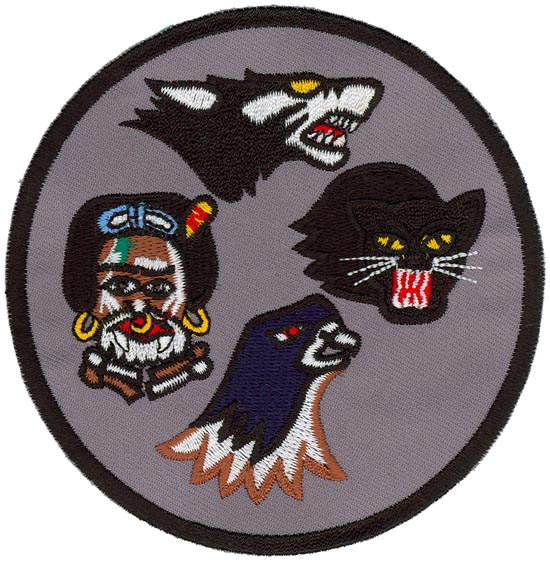Description
Korean computer made 3.75 inch-95mm
8th OPERATIONS GROUP (PACAF)
Lineage. Authorized on the inactive list as the 8 Pursuit Group on 24 Mar 1923. Redesignated 8 Pursuit Group, Air Corps, on 8 Aug 1926. Activated on 1 Apr 1931. Redesignated: 8 Pursuit Group on 1 Sep 1936; 8 Pursuit Group (Fighter) on 6 Dec 1939; 8 Pursuit Group (Interceptor) on 12 Mar 1941; 8 Fighter Group on 15 May 1942; 8 Fighter Group, Single Engine, 20 Aug 1943; 8 Fighter-Bomber Group on 20 Jan 1950. Inactivated on 1 Oct 1957. Redesignated: 8 Tactical Fighter Group on 31 Jul 1985; 8 Operations Group on 1 Feb 1992. Activated on 3 Feb 1992.
Assignments. 2 Bombardment (later, 2; 2 Bombardment) Wing, 1 Apr 1931; 7 Pursuit Wing, 18 Dec 1940; I Interceptor Command, 31 Aug 1941; US Army Forces in Australia, c. 6 Mar 1942; AAF Southwest Pacific Area, Apr 1942; Fifth Air Force, Sep 1942; V Fighter Command, Nov 1942; 315 Composite Wing, c. 31 May 1946; 8 Fighter (later, 8 Fighter-Bomber) Wing, 18 Aug 1948-1 Oct 1957 (attached to 6131 Fighter [later, 6131 Tactical Support] Wing, 14 Aug-1 Dec 1950). 8 Fighter Wing, 3 Feb 1992-.
Components. Squadrons. 33 Pursuit: 25 Jun 1932-Aug 1941. 35 Pursuit (later, 35 Fighter, 35 Fighter-Bomber, 35 Fighter) 25 Jun 1932-1 Oct 1957; 3 Feb 1992-. 36 Pursuit (later, 36 Fighter, 36 Fighter-Bomber): 1 Apr-30 Jun 1931; 15 Jun 1932-1 Oct 1957. 55 Pursuit: 1 Apr 1931-15 Jun 1932. 68 Fighter (later 68 Fighter-All Weather): 15 Dec 1945-19 Feb 1947. 80 Pursuit (later, 80 Fighter, 80 Fighter-Bomber; 80 Tactical Fighter) 10 Jan 1942-26 Dec 1945; 20 Feb 1947-30 Sep 1957, (detached 24 Aug-25 Sep 1950; 25 Sep-27 Oct 1950; 29 Oct 1954-10 Feb 1955; 10 Feb 1955-18 Oct 1956); 3 Feb 1992-.
Stations. Langley Field, VA, 1 Apr 1931; Mitchel Field, NY, c. 5 Nov 1940-26 Jan 1942; Brisbane, Australia, 6 Mar 1942; Townsville, Australia, 29 Jul 1942; Milne Bay, New Guinea, 18 Sep 1942; Mareeba, Australia, Feb 1943; Port Moresby, New Guinea, 16 May 1943; Finschhafen, New Guinea, 23 Dec 1943; Cape Gloucester, New Britain, c. 20 Feb 1944; Nadzab, New Guinea, 14 Mar 1944; Owi, Schouten Islands, 17 Jun 1944; Morotai, 19 Sep 1944; San Jose, Mindoro, 20 Dec 1944; Ie Shima, 6 Aug 1945; Fukuoka, Japan, 22 Nov 1945; Ashiya, Japan, 20 May 1946; Itazuke, Japan, Sep 1946; Ashiya, Japan, 13 Apr 1947; Itazuke, Japan, 25 Mar 1949; Tsuiki, Japan, 11 Aug 1950; Suwon, South Korea, 7 Oct 1950; Kimpo, South Korea, 28 Oct 1950; Pyongyang, North Korea, 25 Nov 1950; Seoul, South Korea, 3 Dec 1950; Itazuke, Japan, 10 Dec 1950; Kimpo, South Korea, 25 Jun 1951; Suwon, South Korea, 24 Aug 1951; Itazuke, Japan, 20 Oct 1954-1 Oct 1957. Kunsan AB, South Korea, 3 Feb 1992-.
Aircraft. Prior to 1940: P-6, P-12, PB-2A, and P-36. P-40, 1940-1941; 1943-1944; P-39, 1941-1943; P-38, 1943-1946; P-47, 1943-1944; P-51, 1946-1950; Aug-Dec 1950; P-80, 1949-1950; 1950-1953; F-86, 1953-1957; F-100. 1957. F-16, 1992-.
Operations. Group trained, took part in maneuvers and reviews, and tested planes and equipment. In Dec 1941, the group became part of the defense force for the New York metropolitan area. Established a headquarters in Australia in Mar 1942 and sent detachments to New Guinea for operations. In Sep 1942 the group moved to New Guinea and served in combat in Feb 1943. Resuming operations in Apr 1943, it served in the theater through the rest of the war, providing cover for Allied landings, escorting bombers, and attacking enemy airfields. It supported operations of the Marines at Cape Gloucester, Feb-Mar 1944; flew long-range escort and attack missions to Borneo, Ceram, Halmahera, and the southern Philippines; provided cover for convoys; and attacked enemy shipping. The organization won a DUC for strafing a Japanese naval force off Mindoro (26 Dec 1944); covered landings at Lingayen; supported ground forces on Luzon; escorted bombers to targets on the Asian mainland and on Formosa; and, in the last days of the war, attacked enemy airfields and railways in Japan. After V-J Day, the group remained as part of the occupation force. It began operations in the Korean War on 26 Jun 1950 by providing cover for the evacuation of US personnel from Seoul, entering into combat the next day. Served in combat until the end of the war, attacking airfields, supply lines, and troop concentrations. Following the war, it performed air defense in Japan and maintained a quick reaction strike force. The group was not operational from 1 Feb 1957 until its inactivation in Oct 1957. Activated again in 1992, and assumed responsibility for flight operations of the 8th Fighter Wing.
Service Streamers. None.
Campaign Streamers. World War II: East Indies; Air Offensive, Japan; China Defensive; Papua; New Guinea; Bismarck Archipelago; Western Pacific; Leyte; Luzon; Southern Philippines; China Offensive. Korea: UN Defensive; UN Offensive; CCF Intervention; First UN Counteroffensive; CCF Spring Offensive; UN Summer-Fall Offensive; Second Korean Winter; Korea, Summer-Fall 1952; Third Korean Winter; Korea, Summer 1953.
Armed Forces Expeditionary Streamers. None.
Decorations. Distinguished Unit Citations: Papua, [Sep] 1942-23 Jan 1943; Philippine Islands, 26 Dec 1944; Korea, 16 Sep-2 Nov 1950. Air Force Outstanding Unit Awards: 1 Aug 1995-31 Jul 1997; 1 Oct 2003-30 Sep 2005. Foreign Decorations: Philippine Presidential Unit Citation; Republic of Korea Presidential Unit Citations; 27 Jun 1950-31 Jan 1951; 1 Feb 1951-31 Mar 1953.
Emblem. Group will use the wing emblem with group designation in the scroll.
